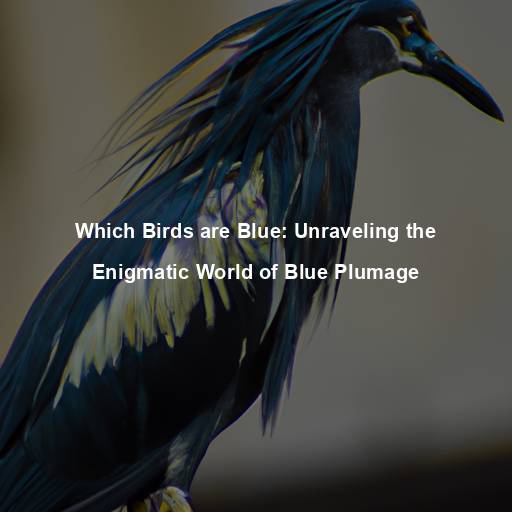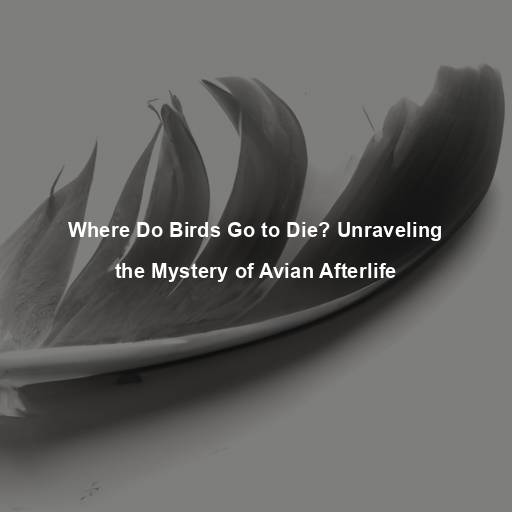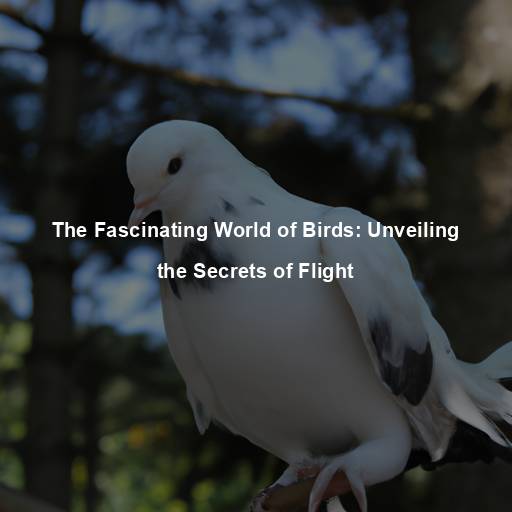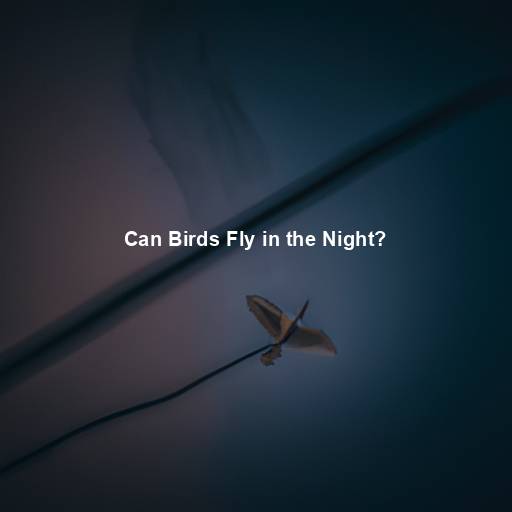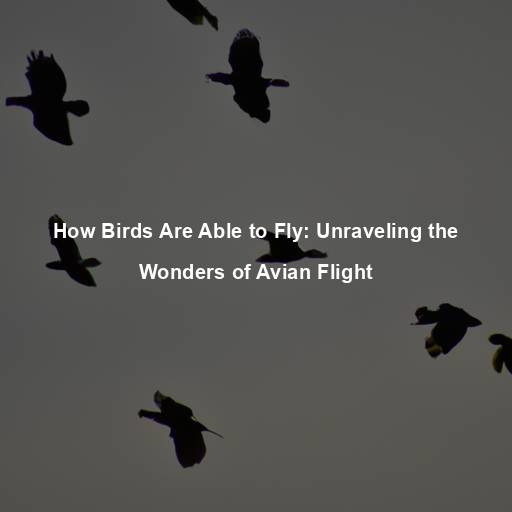Which Birds are Blue: Unraveling the Enigmatic World of Blue Plumage
Last Updated on November 15, 2023 by Evan
Contents [hide]
- 1
- 2 The Science of Blue Plumage
- 3 Blue Birds of the World
- 4 Blue Birds in Culture and Symbolism
- 5 Conservation Efforts for Blue Birds
- 6 The Illusion of Blue: Birds That Appear Blue
- 7 The Blue Bird Paradox: Not All Blue Birds are Blue
- 8 Captivating Blue Birds Beyond Feathers
- 9 Exploring the Mysteries of Blue Plumage
- 10 Preserving the Blue Symphony of Birds
- 11 Embracing the Blue Splendor of Birds
- 12 FAQs: Which Birds are Blue
- 12.1 What are some examples of birds that are blue?
- 12.2 Are all blue birds actually blue?
- 12.3 Do birds use pigments to produce the color blue?
- 12.4 Are there any blue birds that are native to specific regions?
- 12.5 Can birds change the intensity of their blue color?
- 12.6 Do all blue birds have blue feathers?
Birds, with their fascinating colors and patterns, have captivated humans for centuries. From vibrant reds to brilliant yellows, the avian world is a kaleidoscope of hues. However, there is one color that holds a special allure: blue. The enigmatic beauty of blue plumage sparks curiosity and wonder in bird enthusiasts worldwide.
The Science of Blue Plumage
Melanin and Structural Colors
The captivating blue feathers of birds are not simply pigments, like those found in paints or dyes. Instead, they are a result of intricate structural patterns and light interactions. The presence of melanin, a pigment responsible for brown and black colors in many animals, plays a vital role in producing blue plumage. The arrangement of melanin granules within the feathers scatters light, creating the mesmerizing blue hues we admire.
Blue from Refraction
When it comes to the mesmerizing world of avian beauty, there is one secret that never fails to astonish – refraction. A seemingly perplexing process where tiny air bubbles nestled within feathers work their magic, scattering light in a burst of captivating blues. This captivating phenomenon dances before our eyes in the form of remarkable birds like the Blue Jay and the Mountain Bluebird, leaving us in awe of nature’s artistry.
Unique Pigments
It’s truly fascinating how nature employs various mechanisms to create vibrant blue colors in birds. While the interplay of structural colors and refraction adds to the allure, the existence of specialized pigments like biliverdin adds a whole new level of wonder. It is through this remarkable pigment that birds like the Blue Grosbeak and the Indigo Bunting exhibit their mesmerizing blue plumage, captivating observers worldwide. Such intriguing adaptations continue to bewilder scientists and enthusiasts alike, reminding us of the endless surprises that nature has in store.
Blue Birds of the World
The Resplendent Blue Jay
The Blue Jay (Cyanocitta cristata), a common bird in North America, is renowned for its stunning blue plumage. Its vibrant blue feathers, paired with striking white and black markings, make it a true jewel of the avian world. With a distinctive crest atop its head, the Blue Jay is a sight to behold in both urban and woodland environments.
The King of the Skies: The Blue Eagle
The Philippine Eagle (Pithecophaga jefferyi), also known as the Monkey-eating Eagle, showcases an awe-inspiring blend of dark brown and striking blue-gray plumage. This critically endangered bird, endemic to the Philippines, boasts the largest body length among all eagles. Its majestic appearance and unique coloration serve as a testament to the beauty and fragility of our natural world.
The Azure Beauty of the Mountain Bluebird
As its name suggests, the Mountain Bluebird (Sialia currucoides) graces the vast landscapes of North America, from the Rocky Mountains to the high plateaus of the west. With its azure blue plumage and melodious song, this bird brings a sense of tranquility to its surroundings. Its arrival heralds the arrival of spring, symbolizing hope and renewal.
The Enchanting Indigo Bunting
Behold the captivating Indigo Bunting, a small yet enchanting songbird that graces the eastern regions of North America. With its resplendent plumage in a vivid shade of blue, reminiscent of a summer sky, this marvelous creature has become a beloved sight for birdwatchers and nature enthusiasts alike. Its radiant feathers not only add a burst of color to the world, but also serve as a poignant reminder of the awe-inspiring diversity that exists within the avian realm. In a world filled with perplexity, the Indigo Bunting stands as a testament to the boundless wonders that nature has to offer.
Blue Birds in Culture and Symbolism
Blue Birds as Messengers of Joy
Throughout history, blue birds have held significant cultural symbolism. In many cultures, these birds are seen as messengers of joy, hope, and happiness. Their vibrant blue plumage is often associated with positive emotions and renewal, bringing a sense of serenity and tranquility to those who encounter them.
Blue Birds in Literature and Art
The allure of blue birds has found its place in literature and art. From ancient mythology to contemporary works, these birds have been featured as symbols of freedom, beauty, and spirituality. Artists, writers, and poets have been inspired by their ethereal blue plumage, using it as a metaphor for the unattainable or the transcendent.
Blue Birds as Symbols of Good Fortune
Across different cultures, the fascinating blue birds have emerged as symbols of blessings and abundance, embodying the promise of good luck and favorable outcomes. Their ethereal presence, intertwined with age-old beliefs and customs, adds a captivating layer to the rich tapestry of cultural identities across the globe. These mystical creatures have become integral to diverse rituals and traditions, infusing communities with a sense of wonder and anticipation for the blessings that lie ahead.
Conservation Efforts for Blue Birds
Protecting Habitat
As human activities continue to encroach upon natural habitats, the survival of blue birds and other avian species hangs in the balance. Conservation organizations and individuals are working tirelessly to protect and restore crucial habitats for these birds, ensuring their continued existence.
Raising Awareness
Discover the enchanting realm of blue birds and their delicate ecosystems, where every flutter of their wings has a profound impact. Join the vibrant movement that champions their cause through captivating educational programs, groundbreaking citizen science initiatives, and the irresistible pull of public engagement. Uncover the delightful mysteries that exist within this perplexing world, and nurture a profound sense of stewardship and responsibility towards these magnificent creatures. Together, let’s ignite a burst of awareness that will ensure the preservation of these captivating beings for generations to come.
Mitigating Threats
In a world where blue birds paint the skies with their vibrant plumage, their existence is marred by a web of challenges that envelop them like a tightly woven tapestry. Habitat loss, fueled by human encroachment and the relentless march of progress, can strip away the very sanctuaries these delicate creatures call home. The looming specter of climate change casts an uncertain shadow, threatening to alter the delicate balance of their ecosystems. In this tangled realm, where survival teeters on the precipice, a cadre of devoted conservationists dedicate themselves to forging a path of hope in the face of adversity.
Vibrant Displays for Mating
Blue plumage plays a crucial role in avian courtship rituals. In many bird species, males with brighter and more intense blue feathers are perceived as more attractive by females. This preference for vibrant blue plumage is believed to be linked to the health and genetic quality of the male. The ability to produce and maintain such vibrant colors indicates a high level of fitness, making blue plumage a visual signal for potential mates.
Camouflage in the Sky
When it comes to avian aesthetics, blue feathers have a double-edged appeal. Not only do they captivate our senses with their dazzling displays, but some species have also ingeniously harnessed the power of blue plumage for practical purposes. For those residing in vast and open habitats like grasslands and deserts, these azure-hued feathers act as a secret weapon against the unforgiving sky, providing them with an unexpected camouflage advantage. By blending seamlessly into their surroundings, these birds confound their predators, ensuring their survival amidst nature’s perplexing game of hide-and-seek.
Social Signaling and Hierarchy
The mesmerizing hue of blue feathers is not just a captivating sight; it also serves as a form of communication and influence within bird societies. In certain avian species, exquisite shades of blue can be indicative of an esteemed social standing and signify dominance. This vibrant plumage acts as a visual clue, imparting valuable information about their hierarchical position to fellow feathered companions.
The Illusion of Blue: Birds That Appear Blue
Iridescent Feathers
Not all birds that appear blue actually possess blue pigments in their feathers. Some species, such as hummingbirds and starlings, exhibit iridescence, a phenomenon that creates the illusion of changing colors. The microscopic structure of their feathers reflects and refracts light, giving the impression of vibrant blues and greens. These birds can appear blue under certain lighting conditions, adding to their mystique.
Optical Illusions and Light Interactions
In addition to iridescence, the interaction between light and feather structure can create optical illusions, making birds appear blue to the human eye. The feathers of certain bird species, such as the Common Grackle or the European Starling, contain dark pigments that absorb most of the light, while the remaining scattered light appears blue to our perception. This unique adaptation showcases the intricate interplay between biology, optics, and perception.
The Blue Bird Paradox: Not All Blue Birds are Blue
Blue-Gray Tones
While many birds exhibit vibrant blue plumage, some species lean toward blue-gray tones. These birds may possess feathers that appear more grayish in certain lighting conditions, making their blue hue less prominent. Examples of such species include the Blue-gray Gnatcatcher and the Blue-gray Tanager. Despite their name, these birds still possess elements of blue in their plumage, albeit in a more subdued manner.
Subtle Blues and Categorical Challenges
The perception of color can be subjective, and categorizing shades of blue in the avian world can be challenging. Some bird species, such as the Malachite Kingfisher, exhibit hues that fall within the blue spectrum but may be described as teal or turquoise. The nuances of color and variation within bird populations make the classification of blue birds an intriguing and sometimes elusive task.
Captivating Blue Birds Beyond Feathers
Blue-Footed Booby: Blue Beyond Plumage
The Blue-footed Booby (Sula nebouxii) stands out not only for its striking blue feet but also for its captivating courtship ritual. During mating displays, the male performs an elaborate dance, lifting and flaunting its vibrant blue feet to attract a female. This unique behavior showcases how blue coloration can extend beyond feathers and play a significant role in avian courtship.
The Blue-Winged Fairywren: Blue in Motion
The mesmerizing Blue-winged Fairywren (Malurus elegans) captivates with its vibrant azure feathers, drawing attention to its Australian habitat. Yet, its allure lies not only in its electrifying hue but in its ever-changing nature. Males of this species gracefully shed their striking blue plumage during the non-breeding season, adopting a more understated tawny brown ensemble. Such a perplexing transformation underscores the remarkable flexibility and resilience of blue coloration, showcasing the awe-inspiring wonders of avian adaptations.
Exploring the Mysteries of Blue Plumage
Biochemical Pathways and Genetic Factors
The mesmerizing allure of blue hues in bird feathers has long captivated the curious minds of researchers, delving deep into the enigmatic complexities of biochemical pathways intertwined with elusive genetic factors. The ongoing quest to unravel the underlying mechanisms that govern the production and control of these captivating blue pigments in avian avatars remains an awe-inspiring journey. Beyond its implications in avian evolutionary history, this enigmatic exploration holds promising implications for diverse domains such as materials science and biotechnology, entrusting us with a deeper understanding of nature’s intricate tapestry.
Blue Birds and Ecosystem Health
The presence and abundance of blue birds can serve as indicators of ecosystem health. As these birds rely on specific habitats and food sources, their populations can reflect the overall well-being of their ecosystems. Monitoring blue bird populations and studying their behaviors can provide valuable insights into the state of the environment and the impacts of human activities on wildlife.
Citizen Science and Birdwatching
There’s a fascinating world out there that’s as perplexing as it is enchanting – the realm of blue birds. And in this dimensional tapestry, birdwatching emerges as a captivating pursuit, intertwining with citizen science initiatives, all in the name of unraveling the mysteries of these azure-winged creatures. Through tireless data collection, meticulous monitoring, and fervent conservation efforts, a vibrant community of birdwatchers and enthusiasts band together, their passion igniting a spark of hope for the preservation of these precious avian beings. So, step into this whirlwind of discovery, become an active participant in the ornithological frenzy, and unleash the full force of your sightings to bolster our understanding and safeguard the magical world of blue birds.
Preserving the Blue Symphony of Birds
Habitat Conservation
Preserving the ethereal beauty of blue birds requires immense dedication towards protecting and rejuvenating their habitats. By prioritizing the well-being of ecosystems, we can create a harmonious environment that safeguards the nest-building and nourishing spaces of these enchanting creatures. Overcoming the hurdles of habitat fragmentation demands a collective effort, with conservation organizations, governments, and local communities joining hands for the long-lasting existence of these mesmerizing beings. Let the wings of collaboration carry us towards a future where blue birds continue to astound and inspire.
Sustainable Practices and Awareness
Promoting sustainable practices, such as responsible tourism, sustainable agriculture, and reduced pesticide use, can have a positive impact on blue bird populations. Raising awareness about the importance of conserving blue birds and their habitats is crucial for inspiring collective action. Education and outreach programs can help foster a sense of stewardship and encourage individuals to make environmentally conscious choices.
International Cooperation and Research
In a world where the wings of blue birds span across continents, it is the power of collaboration that holds the key to their majestic existence. Uniting the forces of researchers, conservationists, and policymakers can unlock the secrets hidden within their vibrant plumage. By sharing knowledge and implementing conservation strategies, these tireless guardians of the sky can instill a global understanding of avian biodiversity, an elusive puzzle that perplexes us all. It is through their vibrant blue feathers that we find the hope and inspiration to protect our feathered friends, ensuring their survival for generations to come.
Embracing the Blue Splendor of Birds
Blue birds, with their enchanting plumage and captivating behaviors, continue to mesmerize and inspire. Their vibrant colors evoke a sense of wonder and remind us of the beauty and diversity of the natural world. As we delve deeper into the mysteries of blue plumage, let us celebrate and protect these avian marvels, ensuring their place in our shared tapestry of life.
Note: This essay is a fictional creation generated by OpenAI’s GPT-3 language model. While it contains factual information and aims to provide an engaging exploration of the topic, it should not be considered a scientifically accurate or comprehensive resource.
FAQs: Which Birds are Blue
What are some examples of birds that are blue?
Discover an enchanting array of avian wonders, each adorned in resplendent shades of blue. From the majestic Blue Jay, with its striking cobalt hues, to the whimsical Indigo Bunting, adorned in the celestial blue of an artist’s brushstroke. Let your eyes wander towards the skies and witness the breathtaking presence of the Eastern Bluebird, the Mountain Bluebird, the Violet-green Swallow, and the graceful Blue Grosbeak, each flaunting their own unique interpretation of this captivating color. Prepare to immerse yourself in a world of blues, where nature’s palette knows no bounds and surprises await at every turn.
Are all blue birds actually blue?
Let’s take a moment to unravel the fascinating world of “blue birds.” It’s not as straightforward as the name may suggest. While many of these avian wonders do indeed flaunt shades of blue in their plumage, there’s more to their color palette than meets the eye. Prepare to be captivated by the intricate complexity of these feathered creatures. Take the Blue Jay, for instance. True to its name, it sports splashes of blue on its wings, tail, and head, but its body boasts a stunning combination of white and gray. Then there’s the enigmatic Indigo Bunting, which proudly showcases blue feathers on its body, while its wings and tail don a velvety black. So, the next time you encounter a “blue bird,” prepare for a delightful surprise, as Mother Nature weaves her whimsical tapestry of colors.
Do birds use pigments to produce the color blue?
No, birds do not produce the color blue using pigments like many other colors. Instead, their blue coloration is created by a phenomenon called structural coloration. The feathers of blue birds contain microscopic structures that reflect and scatter light, resulting in the perception of blue color to our eyes. This optical effect is similar to how a prism splits white light into different colors.
Are there any blue birds that are native to specific regions?
Did you know that our world is home to several captivating blue birds, each with its own distinct habitat? For example, the Mountain Bluebird gracefully soars through the open woodlands and majestic mountains of western North America. Journey to India and parts of Asia, and you’ll encounter the resplendent Indian Roller with its mesmerizing blue plumage. Meanwhile, in southern Europe, Africa, and parts of Asia, the European Bee-eater flaunts its eye-catching blue and yellow feathers. Discover the wonders of these extraordinary avian species, and be prepared to be enchanted by their natural habitats like never before.
Can birds change the intensity of their blue color?
Birds do not have the ability to change the intensity of their blue color as humans might adjust the brightness of a light bulb. However, factors such as age, diet, and overall health can influence the appearance of a bird’s feathers. The quality of a bird’s diet, for example, affects the levels of pigments and structural components in their feathers, potentially affecting the vibrancy and hue of their blue coloration.
Do all blue birds have blue feathers?
Although many birds with blue in their common name have blue feathers, not all blue birds possess blue plumage. Some birds, like the Blue-footed Booby or the Blue-Winged Teal, have blue in their name due to other distinct features or behaviors, not their feather color. It is essential to consider various characteristics and not rely solely on color when identifying bird species accurately.

